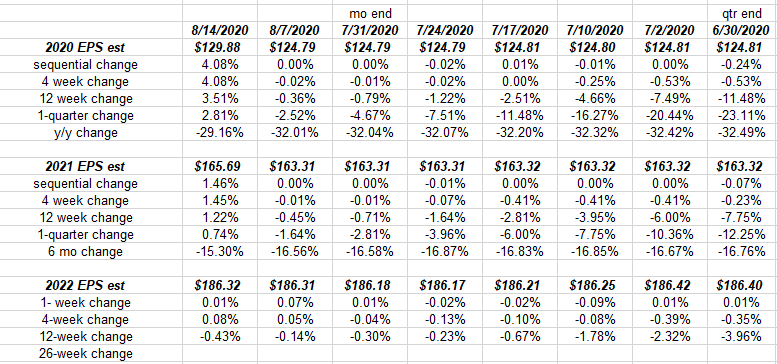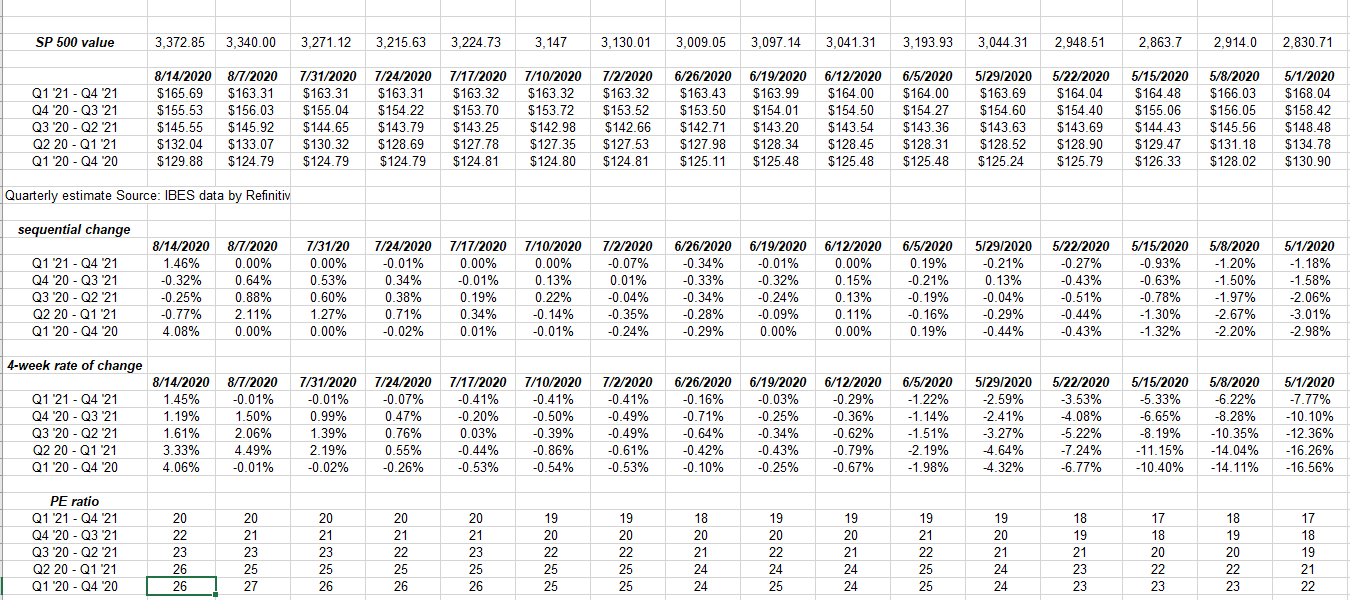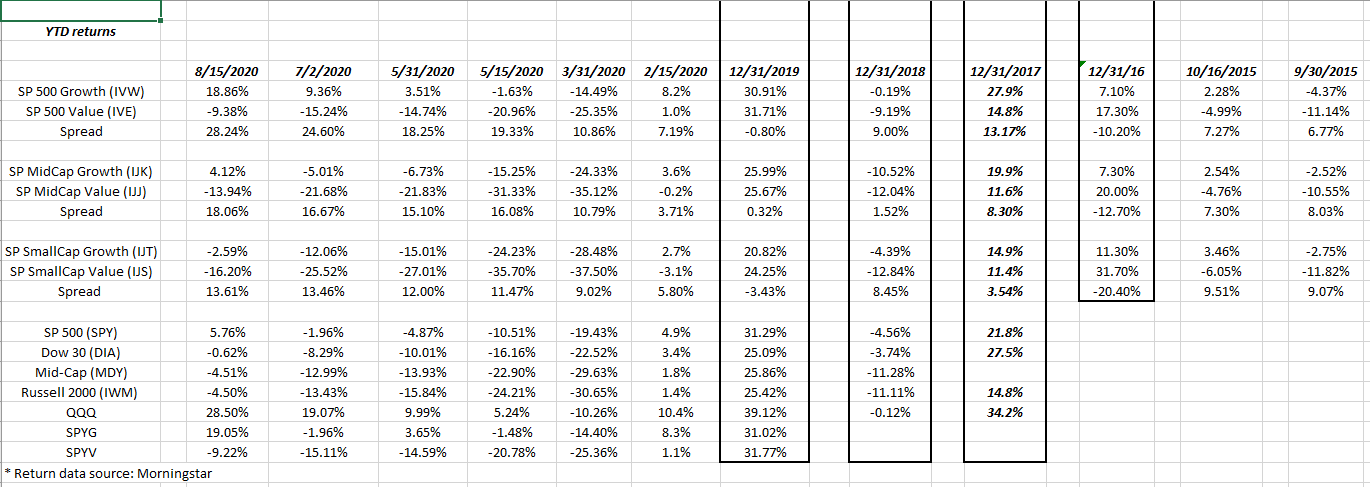The 2Y–10Y Treasury note spread widened out to 57 basis points this week, the widest spread since (wait for it) June 5th’s 69 bps. During the week of June 5th, 2020, the 2–10 spread jumped 20 basis points in the week, while this past week, the spread widened 14 bps from the week prior.
Inflation data is running very hot, but given the increases in the inflation data, the 10-year Treasury taking it in stride (so far).
S&P 500 EPS revisions:
This week, the S&P 500 saw it’s first week of weaker positive revisions since early July, but the important data is the weekly S&P 500 return posted after the revision data.
Only three of the last 13 weeks have seen a negative return for the S&P 500.
For the most part—since late March ’20—S&P 500 “positive revisions” have steadily increased every week since the number bottomed at 12%-13% in the last two weeks of March-April ’20.

Refinitiv sources this data from IBES, but only the last 4 weeks is provided. The above spreadsheet goes all the way back to 2009.
Walmart's (NYSE:WMT) earnings report is Tuesday morning, August 18th. That release unofficially ends the second quarter ’20 earnings season.
S&P 500 Weekly Earnings Update:
- The “forward 4-qtr estimate” fell this week to $145.54 vs last week’s $145.92, the first sequential decline since the week ended June 30 ’20.
- The forward PE is 23x
- The S&P 500 earnings yield is 4.32%, which is still very depressed but not as low as it was in the middle weeks of June ’20 when it struck 4.11% to 4.14%
Last week, this site noted that the annual 2020 and 2021 EPS estimates were unusually stable. (Read the section above the “forward earnings curve”. )
This week that glitch was apparently fixed: note the increase in the annual S&P 500 EPS changed after unusual stability:

Note the increase in 2020 and 2021 S&P 500 estimates this week:
- The 2020 S&P 500 EPS estimate jumped $5.09 per share
- The 2021 S&P 500 EPS estimate jumped $2.38 per share
My guess is there was a glitch somewhere in Refinitiv’s IBES data.
S&P 500 Forward Earnings Curve:

The forward earnings curve showed sharp increases in the “4-week rate of change” as result of the annual S&P 500 EPS estimate increases for 2020 and 2021.
The forward S&P 500 estimates continue to move gradually higher.
Style-Box Update:

In what is no surprise to anyone, large-cap growth continues to dominate the returns of the rest of the small / mid-cap styles.
The bordered boxes are annual returns, and Value hasn’t beaten Growth since 2016.
Some Invesco S&P 500® Equal Weight ETF (NYSE:RSP) has been added to client accounts, but the trend is still your friend.

Michael Reagan of Oppenheimer (probably in Cincinnati) published this last week. Note Tech’s weight in the Russell 1000 Growth index. Yowser.

This graph from Michael Cembalest of JP Morgan shows the Top 5 S&P 500 stocks and their earnings growth relative to the rest of the other 495 and then the Russell 2000.
To think the Russell 2000’s earnings were down as much as 80% y/y by late May ’20.
For those of us who follow “probabalistic” investing, you have to think adding the iShares Russell 2000 ETF (NYSE:IWM) or the Russell 2000 ETF to accounts would make sense.
If the JP Morgan graph doesn’t motivate you on the topic of the Russell 2000 vs. the S&P 500, read this from Nick Colas and Jessica Rabe of DataTrek Research, a neat little blog at a reasonable price:
DAILY DATAPOINT
Two topics today:
#1: Continuing with the theme of cyclical rotation we outlined last night, let’s take a historical look at how the Russell 2000 performs relative to the S&P 500 across economic cycles. The price return timeframe we’ll consider is 200 trading days, about one calendar year. The period of time under our microscope: 2003 to the present, which captures the last 2 complete cycles plus the current environment.
Here is the data – 200 day rolling returns for the Russell 2000 minus the S&P 500. When the line goes above zero the Russell has outperformed the S&P over the last calendar year (roughly) and when it is below it has underperformed.
Three points pop out in this graph:
- The COVID Crisis caused the most pronounced US small cap underperformance since at least 2003.At the worst levels (March 18th, 2020) the Russell’s trailing 200-day price return was 20.0 points worse than the S&P. Prior records were 13-14 points in 2014 and 2019, which were 2 standard deviations (7.5 points) from the mean (0.9 points). By contrast, early 2020’s trailing-year underperformance was almost 3 standard deviations (21.7 points).
- History shows that when the Russell 2000 gets to 10 points of trailing 200-day underperformance, it typically then goes on to outperform the S&P 500.This is clearly visible in the chart, reading from left to right whenever the line touches negative 10 percentage points: January 2008, October 2011, July – December 2014 (a rougher slog, but still worked out), and January – April 2016.
- The one exception – but it is a critical one – is the last 24 months.This is also visible in the graph, which shows that the last time the Russell had a winning 200-day streak against the S&P ended in August 2018. The two years since represent its longest losing run since 2003 by a wide margin.
Takeaway #1: while the Russell has beaten the S&P 500 off the March lows (+61% vs. 51%), our 200-day timeframe analysis says not to take continued outperformance for granted. The missing link – what will keep US small caps working – is real cyclical recovery simply because the Russell has no Big Tech exposure but rather heavier doses of Financials (16%), Industrials (15%), Consumer Discretionary (13%) and even Real Estate (6%) than the S&P 500.
Takeaway #2: history clearly says that if you are confident in a real US economic recovery, then there is still time to overweight the Russell 2000. Back to that chart: all the periods of sustained +10-point small cap outperformance (2003, 2006, 2009 – 2011, 2013, 2016) came either off a cyclical bottom (2003, 2009 – 2011) or just after a mid-cycle growth scare (2006, 2013, 2016). Even with the Russell beating the S&P by 10 points from the bottom, there should still be more room to run because of the inherent earnings leverage of this more-cyclical segment of the US equity market.
- Graph not shown. Tried to pick it up off the blog w/out success. Read the August 11th, DataTrek Research note for the full article. The data and DataTrek’s conclusion from the graph are provided above.
Big Tech is Global, too:

While the topic has been thoroughly exhausted in terms of Big Tech’s dominance of market-cap weighted indices, Nick Colas and Jessica Rabe talk about the dominance of Big Tech across global markets, not just the S&P 500 and the NASDAQ.
Summary / conclusion: The case continues to grow for some “rotation” into beaten-down sectors of the capital markets, except for the fact that the S&P 500’s Big 5 (top 5 market-cap names in the S&P 500) earnings and revenue continue to grow well above the rate of the rest of the S&P 500 and anywhere else around the globe. To call them the only game in town, is not a gross oversimplification.
And yet, we all know that will change some day.
Selling Apple (NASDAQ:AAPL) and Facebook (NASDAQ:FB) was gross stupidity in 2018, but I never thought Apple would make the seamless transition to the services business from a tech hardware company, and Facebook’s Cambridge Analytica fiasco and what they did with user data, made me conclude the company wasn’t trustworthy.
Wow, those two sales did not stand the test of time very well.
This tech dominance will end at some point. One potential catalyst could be the 2020 Presidential election. The two parties have very different views towards business, regulation and global trade.
The thing is, in 2000, the NASDAQ had peaked well before the election in November, 2000. Intel (NASDAQ:INTC) was the first earnings warning in September, 2000 and then Cisco (NASDAQ:CSCO) followed in January, 2001.
Funny, that 20 years later the same two stocks are warning again, just from very different valuation levels and growth expectations.
I struggled with today’s post and jumped around in terms of topics. Hope readers found it helpful.
Take everything you read here with a substantial skepticism. Make decisions based on your own financial condition and profile, and your own circumstances.
